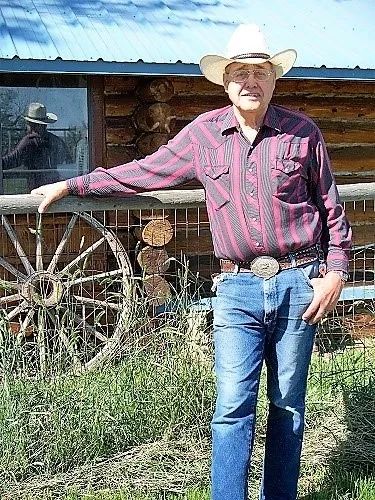
MCHF & WHC HALL OF FAME INDUCTEE 2018
Harvey L. Rattey (1938-2015)
Harvey Leslie “Harv” Rattey was the third of five children born to Lester and Rose (LaTray) Rattey in a log cabin near Chinook, Montana, in Blaine County on October 29, 1938.
Soon after Harvey was born, his dad went to town and brought the doctor out to examine their new son. The doctor told Lester to come to town later and bring him the name for the baby. The next day, with a supply list on one paper and a boy’s name on another, Lester dropped off what he thought was the correct paperwork and went to get the needed item.
Some time later, the doctor personally delivered the birth certificate and inquired if they were sure they wanted to name the baby “Kerosene”. Lester had obviously given the doctor the wrong document. This story was a favorite, retold many times throughout the years during the gathering of family and their friends.
Harvey Rattey, an enrolled member of the Little Shell Band of Chippewa, grew up on a ranch bordering the Fort Belknap Indian Reservation. He loved animals, rodeo, and story-telling and became an award winning Golden Gloves Boxer.
One day while Harvey was in high school, his dad brought home two unbroke horses from the livestock auction which incited a sense of unhappiness with his Mom. Lester defensively related that one was for Harvey, who quickly claimed the best-looking one of the two as his own. The Russians had just launched the satellite Sputnik, which inspired Harvey to name his new horse the same. He and his beloved Sputnik entered numerous rodeos in Montana for more than 25 years.
Harvey graduated from high school in Harlem, Montana. He and his brother Joe joined the United States Army in June 1960 and attended military boot camp together. Their very first trip out of Montana found them stationed in Germany.
When Lester broke his back, he requested the Army send his son home on a hardship discharge as he was needed to oversee the ranch in Dodson, Montana. Harvey liked to tell the story of how on the U.S. Navy ship home, he was so seasick he had to stay with the military working dogs. The soldiers slept below deck, while the dogs were kenneled above. He never did say if he was issued a kennel or just a sleeping bag. Harvey went on to proudly serve six years in the Montana National Guard.
Several years later, Harvey bought into the Riggin Grazing Association near Turner, Montana. The association enveloped more than a quarter million acres. Harvey became the ranch manager, and oversaw 2,500 head of cattle, several hundred miles of fence line, and broke horses for neighbors.
During this time, Harvey started sculpting with wax and in 1971, he decided to devote full-time to this new-found passion. In pursuit of his art, he moved to Bozeman, Montana. Harvey’s first sculptures were a rodeo series in wax.
Harvey became the Artist in Residence for the Medora Museum in Medora, North Dakota. That summer, he learned about the lost wax casting process and began having his sculptures cast in bronze.
Harvey’s love of cowboys and wildlife inspired him to sculpt both subjects with empathy and realistic action. His greatest interest lay in portraying his people and their way of life spanning the last nomadic Indians to contemporary Indians in the mainstream of modern society.
In 1977, Harvey married sculptor Pamela Harr. They started Bridger Bronze casting foundry in Bozeman. They shared raising Harvey’s daughter from his first marriage with her mom. Harvey and Pam then adopted 5 more Native American children. In 1996, they bought a ranch and moved to Glendive, Montana to raise Angus cattle and continue sculpting.
Representatives of the Pentagon have presented Harvey’s eagle bronzes to dignitaries in over 32 countries. He also has an eagle in the Permanent Art Collection of the White House in Washington, District of Columbia. Harvey is a recipient of numerous national sculpture and business awards.
Harvey’s work is included in the Augustana Historical Center, Sioux Falls, South Dakota, as well as several other museum collections. A narrative of his life is included in the Smithsonian’s Local Legacies Project in Washington, D.C.
Harvey’s array of more than 1,100 different sculptures are owned by collectors in all walks of life including congressmen, heads of state, and celebrities such as Ross Perot, Bill Cosby, and Larry Bird.
Harvey donated many sculptures throughout his career and has helped raise thousands of dollars for charities.
In 2003, Harvey was appointed by Montana Governor Brian Schweitzer to the Montana State Veteran’s Board. He served for two terms as a representative of Native American Veterans.
Harvey lived his life as he thought a cowboy ought to - with honesty and integrity. If someone needed a hand, he would be there to help and support. His enthusiasm for life and love of people shown brightly through his countless entertaining stories, usually told with a joke on himself.
Harvey Rattey passed away at the Eastern Montana Veteran’s Home in Glendive on December 7, 2015. His ashes are buried in the Dodson Cemetery, along with those of his mom, dad, and Harvey’s infant son from his first marriage.
On the back of Harvey’s military headstone is an engraving of him roping a calf and his favorite saying, “Where the pavement ends & the West begins”.
Resources: Rattey family memories

